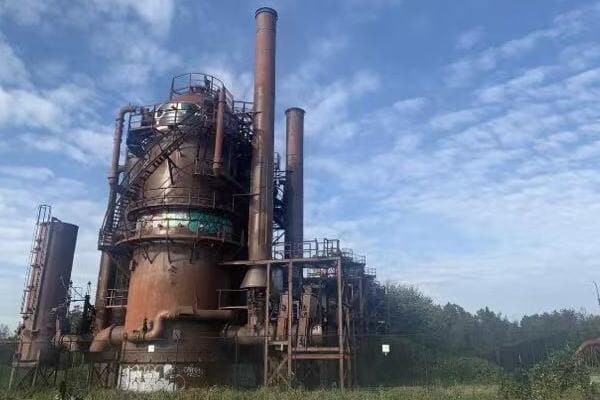Denny Substation: How Seattle Reinvented the Power Station as Urban Public Space?
Have you ever walked past a power station and thought, "This could be so much more"? Seattle did, and the result is nothing short of revolutionary. The Denny Substation is changing how we think about urban infrastructure.
Denny Substation in Seattle is a groundbreaking project that combines a fully functioning electrical substation with public spaces and amenities. It reimagines industrial infrastructure as an integral part of the urban fabric, offering community benefits while meeting the city’s growing energy needs.
As an electrical engineer who’s worked on numerous substation projects, I was skeptical when I first heard about Denny Substation. But after visiting the site and studying its design, I’m convinced it’s a game-changer for urban power infrastructure. Let me take you on a tour of this innovative project and show you why it matters.
Architectural Innovation: Blending Power Infrastructure with Urban Design in Denny Substation?
When you think of a power substation, what comes to mind? Probably not an award-winning piece of architecture. But Denny Substation is changing that perception, one visitor at a time.
Denny Substation’s design seamlessly integrates industrial functionality with aesthetic appeal. Its sloped walls, public art installations, and transparent sections allow passersby to glimpse the inner workings of the substation, demystifying power infrastructure while enhancing the urban landscape.

I’ve seen my fair share of substations, but Denny is in a league of its own. Let’s break down what makes its architecture so innovative:
Form Meets Function: The Substation’s Unique Design
The substation’s design is a masterclass in blending form and function:
-
Sloped Walls
- Reduce the visual bulk of the building
- Create a dynamic, sculptural form
-
Transparent Sections
- Allow public viewing of internal equipment
- Educate visitors about power infrastructure
-
Integrated Public Art
- Enhances aesthetic appeal
- Reflects local culture and history
Public Engagement Through Design
Denny Substation goes beyond just looking good:
| Feature | Purpose | Benefit |
|---|---|---|
| Elevated Walkway | Provides views into the substation | Educates public about power systems |
| Interactive Exhibits | Explains substation operations | Increases energy awareness |
| Open Spaces | Creates gathering areas | Fosters community engagement |
Challenges in Blending Infrastructure and Architecture
Designing Denny Substation wasn’t without its challenges:
-
Safety Considerations
- Ensuring public safety near high-voltage equipment
- Implementing secure yet visually appealing barriers
-
Noise Mitigation
- Designing acoustically insulated walls
- Strategically placing noisy equipment
-
Electromagnetic Field (EMF) Management
- Careful layout to minimize EMF exposure in public areas
- Using advanced shielding techniques
I remember discussing these challenges with the project team. We had to think outside the box to find solutions that didn’t compromise the substation’s functionality or aesthetic vision.
The Impact on Urban Planning
Denny Substation is more than just a pretty face:
- It sets a new standard for infrastructure design in urban areas
- It demonstrates that utility buildings can contribute positively to cityscapes
- It encourages public engagement with typically "invisible" city systems
As I walked around the substation, I couldn’t help but imagine how this approach could transform other urban infrastructure projects. The possibilities are exciting.
Remember, Denny Substation isn’t just about making a power facility look good. It’s about reimagining how our cities can integrate essential infrastructure in ways that benefit and engage the community. It’s a bold step towards more livable, understandable urban environments.
Community Integration: Public Spaces and Amenities Within a Functioning Power Facility?
When was the last time you thought of hanging out at a power substation? Probably never. But Denny Substation is changing that narrative, turning a typically off-limits area into a community hub.
Denny Substation incorporates various public amenities, including a quarter-mile walking loop, dog park, meeting spaces, and educational exhibits. These features transform the substation from a purely industrial site into a multifunctional community space, all while maintaining its core function as a power facility.

As someone who’s spent years working on traditional substations, I was amazed by Denny’s approach. Let’s explore how this substation has become an integral part of its community:
Reimagining Public Spaces
Denny Substation offers a range of public amenities:
-
Walking Loop
- Quarter-mile elevated path
- Provides unique views of the city and substation
-
Off-Leash Dog Park
- Safe space for pets in an urban environment
- Encourages community gatherings
-
Community Meeting Rooms
- Available for public use
- Fosters local engagement and activities
-
Educational Exhibits
- Interactive displays about energy and sustainability
- Promotes public understanding of power systems
Balancing Public Access and Operational Safety
Integrating public spaces with a functioning substation presented unique challenges:
| Challenge | Solution | Benefit |
|---|---|---|
| Safety Concerns | Clear barriers and signage | Safe public access |
| Noise Issues | Advanced sound insulation | Quiet public areas |
| EMF Exposure | Strategic equipment placement | Minimal EMF in public spaces |
| Security | Monitored access points | Protected critical infrastructure |
I was particularly impressed with how the design team addressed these challenges without compromising the substation’s welcoming atmosphere.
Community Engagement and Education
Denny Substation goes beyond providing spaces; it actively engages the community:
-
Energy Education Programs
- School field trips
- Adult learning workshops
-
Public Art Installations
- Rotating exhibits by local artists
- Permanent pieces integrated into the structure
-
Sustainability Demonstrations
- Showcasing green technologies
- Inspiring visitors to adopt eco-friendly practices
During my visit, I saw a group of students on a field trip, eagerly learning about power generation. It was a stark contrast to the "keep out" mentality of traditional substations.
The Social Impact of an Open Substation
The integration of Denny Substation into the community fabric has far-reaching effects:
-
Increased Public Awareness
- Better understanding of power infrastructure
- Greater appreciation for energy conservation
-
Enhanced Neighborhood Amenities
- Improved quality of life for local residents
- Increased property values in the area
-
Community Cohesion
- New gathering spaces for social interaction
- Platform for community events and activities
Challenges and Lessons Learned
Implementing this community-integrated model wasn’t without its hurdles:
-
Initial Public Skepticism
- Concerns about safety and EMF exposure
- Addressed through transparent communication and education
-
Operational Complexities
- Balancing public access with facility maintenance
- Developing new protocols for a unique situation
-
Cost Considerations
- Higher initial investment compared to traditional substations
- Long-term benefits in public relations and community development
As I reflected on these challenges, I realized that Denny Substation’s approach, while more complex, offers a blueprint for how infrastructure can positively contribute to urban life.
Remember, Denny Substation isn’t just powering homes and businesses; it’s powering community engagement and education. It’s a testament to how thoughtful design can transform a necessary piece of infrastructure into a valuable community asset.
Balancing Act: Meeting Seattle’s Energy Needs While Creating an Inviting Urban Environment?
How do you reconcile the industrial nature of a power substation with the desire for inviting urban spaces? This was the challenge faced by Seattle City Light, and their solution at Denny Substation is nothing short of ingenious.
Denny Substation successfully balances Seattle’s growing energy demands with the need for attractive urban spaces. It incorporates state-of-the-art electrical equipment within an architecturally striking and publicly accessible design, demonstrating that utility infrastructure can enhance rather than detract from the urban environment.

As an electrical engineer, I’ve always been fascinated by the technical aspects of substations. But Denny takes it to a whole new level by marrying technical excellence with urban design. Let’s dive into how they achieved this balance:
Technical Prowess Meets Urban Aesthetics
Denny Substation is a marvel of engineering and design:
-
Electrical Capacity
- 405 megavolt-amperes (MVA) capacity
- Serves Seattle’s growing downtown and South Lake Union areas
-
Compact Design
- Uses gas-insulated switchgear (GIS) to minimize footprint
- Allows for more public space within the site
-
Noise Reduction
- Advanced sound-absorbing materials
- Strategic equipment placement to minimize noise pollution
| Feature | Technical Benefit | Urban Benefit |
|---|---|---|
| GIS Technology | Reduced equipment size | More space for public amenities |
| Underground Cabling | Improved reliability | Cleaner visual aesthetics |
| Modular Design | Easier future upgrades | Adaptable public spaces |
Innovative Design Solutions
The substation’s design tackles several challenges:
-
Visual Impact
- Sloped walls reduce perceived height
- Green walls and landscaping soften industrial appearance
-
Public Safety
- Clear separation between public and operational areas
- Educational signage about electrical safety
-
Environmental Considerations
- Rainwater harvesting system
- Energy-efficient lighting and HVAC systems
I was particularly impressed by how the design team turned potential problems into opportunities for innovation.
Balancing Operational Needs with Public Access
Maintaining a functioning substation while allowing public access required careful planning:
-
Secure Perimeters
- Clear boundaries between public and restricted areas
- Advanced security systems to protect critical infrastructure
-
Flexible Spaces
- Areas that can be repurposed for maintenance when needed
- Public spaces designed to not interfere with substation operations
-
Educational Integration
- Viewing windows into operational areas
- Interactive displays explaining substation functions
During my tour, I noticed how seamlessly the public areas blended with the operational sections. It’s a testament to thoughtful design and planning.
The Impact on Seattle’s Energy Infrastructure
Denny Substation isn’t just about looks; it’s a crucial part of Seattle’s power grid:
-
Increased Capacity
- Supports urban growth and development
- Enhances grid reliability in downtown areas
-
Smart Grid Integration
- Advanced monitoring and control systems
- Prepared for future energy technologies
-
Renewable Energy Support
- Designed to handle variable inputs from renewable sources
- Promotes Seattle’s clean energy goals
Challenges in Implementation
Creating this balanced environment wasn’t without its hurdles:
-
Regulatory Compliance
- Meeting both energy and public space regulations
- Developing new standards for this hybrid model
-
Cost Management
- Higher initial investment than traditional substations
- Justifying expenses for public amenities
-
Operational Adjustments
- Training staff for a public-facing facility
- Developing new maintenance protocols
As I discussed these challenges with the project team, I was struck by their innovative problem-solving approaches. They didn’t just overcome obstacles; they turned them into opportunities for improvement.
Remember, Denny Substation isn’t just about providing power or creating public spaces. It’s about reimagining what urban infrastructure can be. It shows that with creativity and commitment, we can create facilities that serve multiple purposes, enriching our cities in more ways than one.
Sustainability and Technology: Green Features and Smart Grid Capabilities of Denny Substation?
In an era where sustainability is no longer optional, how does a power substation – traditionally seen as an energy-hungry facility – become a beacon of green technology? Denny Substation provides a compelling answer to this question.
Denny Substation incorporates numerous sustainable features and smart grid technologies. From its energy-efficient design and rainwater harvesting system to its advanced monitoring and control capabilities, the substation sets new standards for environmentally responsible and technologically advanced power infrastructure.

As someone who’s passionate about integrating sustainability into power systems, I was eager to explore Denny’s green features. Let’s dive into what makes this substation a leader in sustainable and smart technology:
Green Building Design
Denny Substation’s commitment to sustainability starts with its very structure:
-
Energy-Efficient Building Envelope
- High-performance insulation
- Double-paned, low-E windows
-
Green Roof
- Reduces urban heat island effect
- Improves stormwater management
-
Sustainable Materials
- Recycled and locally sourced materials
- Low-VOC paints and adhesives
| Feature | Environmental Benefit | Operational Benefit |
|---|---|---|
| LED Lighting | Reduced energy consumption | Lower maintenance costs |
| Natural Ventilation | Decreased HVAC needs | Improved air quality |
| Solar Panels | On-site renewable energy | Reduced grid dependency |
Water Conservation Measures
The substation takes water management seriously:
-
Rainwater Harvesting System
- Collects and stores rainwater for non-potable uses
- Reduces demand on municipal water supply
-
Low-Flow Fixtures
- Minimizes water usage in public areas
- Sets an example for water conservation
-
Drought-Resistant Landscaping
- Reduces irrigation needs
- Promotes native plant species
During my visit, I was impressed by how these water-saving features were seamlessly integrated into the substation’s design.
Smart Grid Integration
Denny Substation is at the forefront of smart grid technology:
-
Advanced Monitoring Systems
- Real-time data on power flow and equipment status
- Predictive maintenance capabilities
-
Automated Control Systems
- Rapid response to grid fluctuations
- Improved power quality and reliability
-
Integration with Renewable Energy Sources
- Ability to handle variable inputs from solar and wind
- Support for distributed energy resources
Energy Efficiency in Operations
The substation doesn’t just distribute power; it uses it wisely:
-
High-Efficiency Transformers
- Reduce energy losses during voltage conversion
- Exceed current efficiency standards
-
Optimized Cooling Systems
- Use of natural convection where possible
- Energy-efficient mechanical cooling when necessary
-
Demand Response Capabilities
- Ability to adjust operations based on grid demands
- Supports overall grid stability and efficiency
I was particularly fascinated by how these efficiency measures were implemented without compromising the substation’s core functions.
Environmental Impact Reduction
Denny Substation goes beyond energy and water savings:
-
Noise Reduction Measures
- Sound-absorbing materials and designs
- Minimizes impact on surrounding neighborhood
-
EMF Mitigation
- Strategic equipment placement and shielding
- Ensures public safety in and around the facility
-
Air Quality Considerations
- Use of SF6 gas alternatives where possible
- Monitoring and containment systems for emissions
Challenges in Implementing Green Technologies
Integrating these sustainable features wasn’t without its challenges:
-
Initial Cost Considerations
- Higher upfront investment for green technologies
- Need to justify long-term benefits
-
Technological Integration
- Ensuring compatibility between various smart systems
- Maintaining cybersecurity in an increasingly connected environment
-
Regulatory Navigation
- Meeting both energy and environmental regulations
- Setting new standards for green substation design
As I discussed these challenges with the project team, I was impressed by their commitment to overcoming obstacles in pursuit of sustainability.
Future-Proofing the Substation
Denny Substation isn’t just built for today; it’s designed for the future:
-
Expandable Smart Grid Capabilities
- Ready for future technological advancements
- Adaptable to changing energy landscapes
-
Climate Change Considerations
- Designed to withstand potential environmental changes
- Flexible operations to adapt to shifting energy demands
-
Community Education Programs
- Ongoing initiatives to promote sustainability awareness
- Inspiring visitors to adopt eco-friendly practices
Remember, Denny Substation isn’t just a power distribution facility; it’s a living laboratory for sustainable urban infrastructure. It demonstrates that with innovative thinking and commitment, we can transform traditionally industrial facilities into beacons of sustainability and technological innovation.
A New Paradigm: Lessons from Denny Substation for Future Urban Infrastructure Projects?
Can a single substation project change the way we think about urban infrastructure? Denny Substation in Seattle proves that it can, offering valuable lessons for cities worldwide.
Denny Substation sets a new standard for urban infrastructure projects, demonstrating that essential utilities can be integrated into the urban fabric in ways that benefit the community. It offers lessons in public engagement, sustainable design, and the fusion of technology with urban planning.

As an engineer who’s worked on numerous infrastructure projects, I’ve seen firsthand how Denny Substation is reshaping our approach to urban planning. Let’s explore the key lessons this innovative project offers:
Rethinking Public Engagement
Denny Substation revolutionizes how we involve the public in infrastructure projects:
-
Early Community Involvement
- Engaged residents in the design process from the start
- Incorporated community feedback into final plans
-
Transparency in Development
- Regular public updates throughout construction
- Open houses and tours to explain the project
-
Ongoing Educational Programs
- Continuous engagement through on-site exhibits
- School programs and community workshops
| Engagement Method | Traditional Approach | Denny Substation Approach |
|---|---|---|
| Public Meetings | Limited, formal sessions | Frequent, interactive workshops |
| Information Sharing | Technical documents | Accessible displays and tours |
| Community Input | Minimal consideration | Integral to design process |
Integrating Infrastructure with Urban Design
The project showcases how infrastructure can enhance rather than detract from urban spaces:
-
Multifunctional Design
- Combines utility function with public amenities
- Creates value beyond its primary purpose
-
Aesthetic Consideration
- Architecturally significant design
- Enhances the visual appeal of the neighborhood
-
Public Space Creation
- Incorporates parks, walkways, and gathering areas
- Turns utility land into community assets
During my visits to Denny Substation, I’ve been struck by how seamlessly it blends into the urban landscape while still standing out as a unique landmark.
Sustainability as a Core Principle
Denny Substation demonstrates how infrastructure projects can lead in sustainability:
-
Green Building Practices
- LEED certification standards
- Use of recycled and sustainable materials
-
Energy Efficiency
- Innovative cooling and lighting systems
- On-site renewable energy generation
-
Water Conservation
- Rainwater harvesting and reuse
- Drought-resistant landscaping
Embracing Technological Innovation
The project showcases the potential of smart infrastructure:
-
Advanced Grid Management
- Real-time monitoring and control systems
- Preparation for future smart city integration
-
Flexible Design for Future Technologies
- Adaptable spaces for equipment upgrades
- Ready for emerging energy technologies
-
Data-Driven Operations
- Use of IoT sensors for predictive maintenance
- Optimization of energy distribution based on usage patterns
Challenges and Solutions in Implementation
Implementing this new paradigm wasn’t without obstacles:
-
Regulatory Hurdles
- Navigating existing zoning laws
- Setting new precedents for mixed-use utility spaces
-
Cost Justification
- Higher initial investment than traditional substations
- Demonstrating long-term community and operational benefits
-
Operational Complexities
- Managing public access alongside utility operations
- Ensuring security without creating a fortress-like atmosphere
As I discussed these challenges with project leaders, I was impressed by their innovative problem-solving approaches and commitment to the vision.
Lessons for Future Projects
Denny Substation offers valuable insights for other cities and infrastructure planners:
-
Holistic Planning
- Consider infrastructure as part of the urban ecosystem
- Look for opportunities to create multi-use spaces
-
Community-Centric Design
- Prioritize community needs and input
- Create infrastructure that adds value to neighborhoods
-
Forward-Thinking Technology Integration
- Design for future technological advancements
- Incorporate smart systems from the ground up
-
Sustainability Focus
- Make environmental responsibility a core design principle
- Showcase green technologies to educate and inspire
-
Transparency and Education
- Use infrastructure projects as opportunities for public education
- Be open about processes, challenges, and benefits
The Ripple Effect
The impact of Denny Substation extends beyond Seattle:
-
Inspiring Other Cities
- Serving as a model for urban infrastructure projects worldwide
- Encouraging rethinking of existing utility spaces
-
Changing Public Perception
- Transforming the image of utility infrastructure
- Fostering public interest in and understanding of power systems
-
Influencing Policy and Regulation
- Prompting updates to urban planning guidelines
- Encouraging more flexible approaches to infrastructure development
Remember, Denny Substation isn’t just a one-off project; it’s a blueprint for the future of urban infrastructure. It shows us that with creativity, community engagement, and a commitment to sustainability, we can transform necessary utilities into valuable community assets. As cities worldwide grapple with aging infrastructure and growing populations, the lessons from Denny Substation offer a path forward – one where our urban necessities become opportunities for innovation, education, and community building.
Conclusion
Denny Substation represents a paradigm shift in urban infrastructure design, seamlessly blending functionality with community engagement and sustainability. It sets a new standard for how cities can integrate essential utilities into the urban fabric, creating value beyond power distribution.
Free CHBEB Transformer Catalog Download
Get the full range of CHBEB transformers in one catalog.
Includes oil-immersed, dry-type, pad-mounted, and custom solutions.
Quick Message
Request A free quote
We'd like to work with you
- +86 15558785111
- [email protected]
- +86 15558785111
What We Do
CHINA BEI ER BIAN (CHBEB) GROUP, with 218 million in registered capital, originated from Beijing Beierbian Transformer Group. Headquartered in Beijing for R&D, it operates major production bases in Nanjing and Yueqing, producing high-quality products.
Latest Product
address
BeiJing
No 3,RongJing East Road,BeiJing Economic Technological Development Area,BeiJing,China
JiangSu
No 7️Xiangfeng Road,Jiangning,NanJing,JiangSu,China
WenZhou
No.211, Wei 16 Road, Industrial Zone, Yueqing, Wenzhou, Zhejiang, China.
XiangYang Industrial Zone ,YueQing,WenZhou,ZheJiang,China
contact us
- [email protected]
- +86 13057780111
- +86 13057780111
- +86 15558785111
Copyright © Bei Er Bian Group



